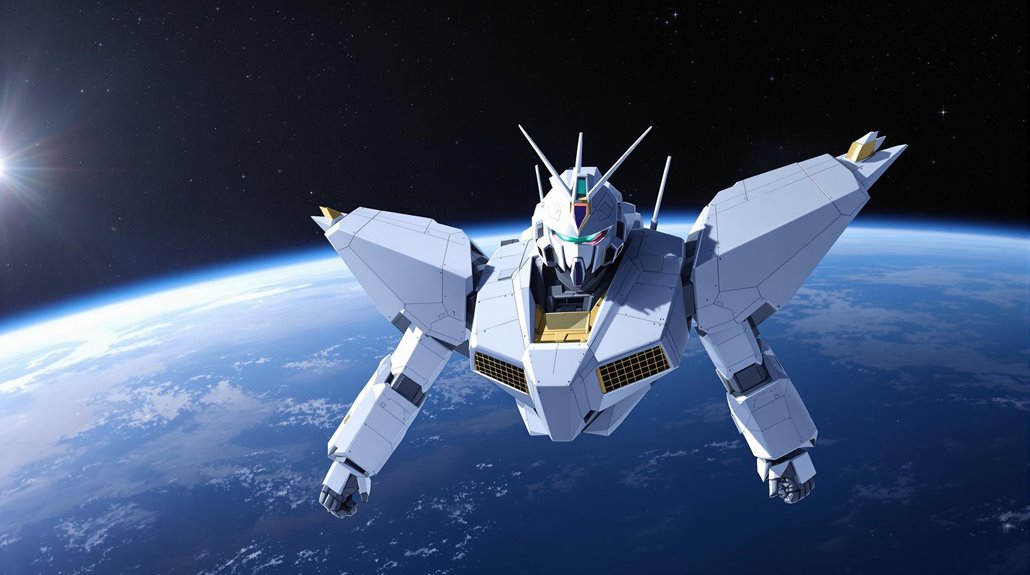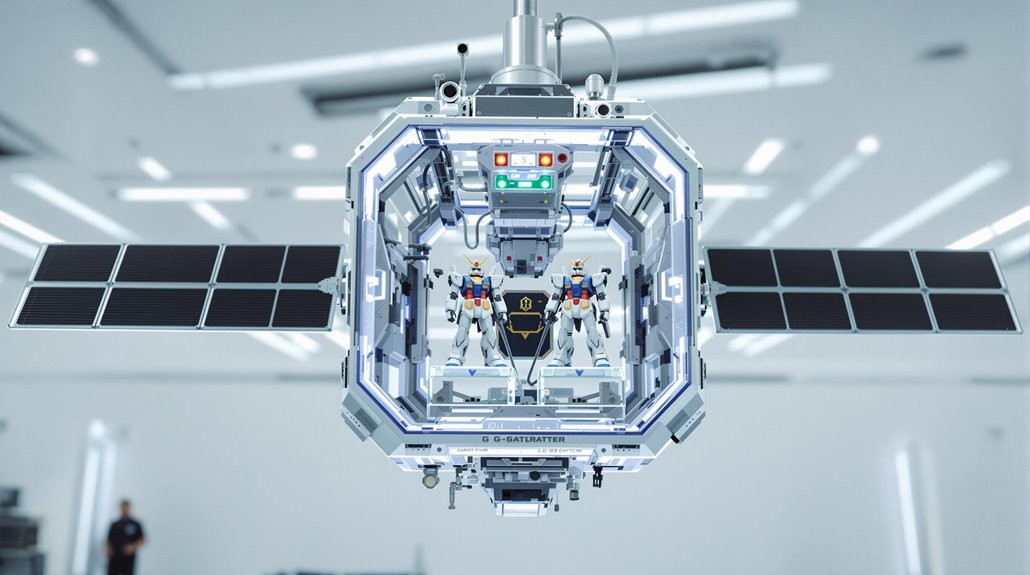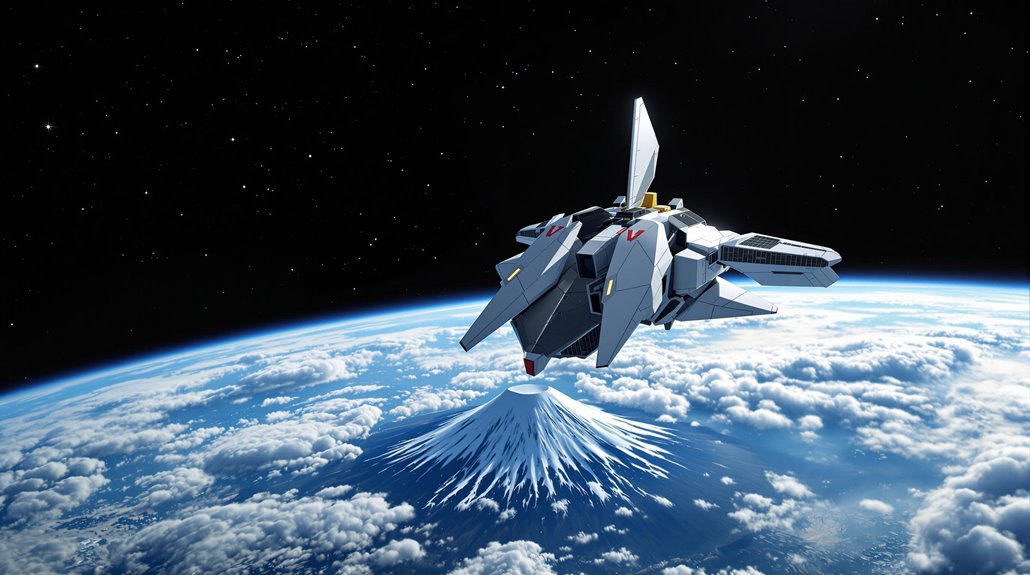What Is the Gundam Satellite Project?

The G-SATELLITE project launched two Gundam model figures into space aboard a SpaceX Dragon flight in March 2020. You'll find these specially modified Gunpla models, a Gundam and Char's Zaku, mounted on a tiny 4x4x11.8-inch satellite equipped with seven cameras. The models' eyes display Olympic ring colors while broadcasting messages from orbit. This collaboration between the University of Tokyo and JAXA combines Japan's space technology with pop culture in ways you won't believe.
Origins and Vision of the G-SATELLITE Mission
While Japan has launched numerous satellites into space, the G-SATELLITE mission stands apart as a unique fusion of pop culture and aerospace technology. Born from a collaboration between the University of Tokyo and JAXA, this innovative project aims to orbit a microsatellite carrying two iconic robot models: a Gundam and Char's Zaku.
During the Tokyo 2020 Games, the G-SATELLITE will broadcast support messages while its robotic passengers display the Olympic colors through their eyes, captured by onboard cameras. It's a creative strategy to showcase Japan's technological prowess and cultural influence. The project's ultimate vision is to inspire young minds worldwide, connecting space exploration with popular culture while celebrating the Olympic spirit in an unparalleled way.
You'll find this miniature satellite's purpose goes beyond mere symbolism.
The mission celebrates Japan's rich heritage in plastic model kits that began with Bandai's first Gundam release in 1980.
Technical Specifications of the Space-Bound Gunpla Models
Ever wonder what it takes to prepare toy robots for space? The G-SATELLITE's Gundam and Char's Zaku models aren't your typical plastic toys. These Gunpla figures are getting a special resin coating to protect them from the harsh conditions of outer space, where they'll orbit aboard a compact 4 x 4 x 11.8-inch satellite.
You'll be able to spot these aerospace pioneers through the G-SATELLITE's seven mounted cameras as they float above Earth. What's more impressive is that their eyes will cycle through the five Olympic colors, broadcasting greeting messages from the International Space Station.
The launch plan involves deploying these specially modified Gunpla models from the station's Japanese Experiment Module, marking a unique fusion of pop culture and space exploration.
Unlike standard plastic Gundam kits, these space-bound models required significant material modifications to withstand the extreme environment.
Core Components of the G-SATELLITE System

Inside the compact G-SATELLITE, several critical components work together to make this unique space mission possible. At its core, you'll find two specially modified Gunpla models - a Gundam and Char's Zaku - treated with protective resin to withstand the harsh conditions of space. The satellite features an advanced camera system comprising seven individual cameras that'll capture the models' movements and activities while in orbit.
The G-SATELLITE's electronic systems, developed through aerospace engineering collaboration between JAXA and the University of Tokyo, control the models' eye-lighting sequences, displaying the five Olympic colors. These same systems manage the satellite's communication capabilities, allowing it to transmit messages back to Earth. The entire setup is housed within a remarkably small frame measuring just 4 x 4 x 11.8 inches. The Gunpla models used in the satellite are similar in size to High Grade models, which typically measure around 5 inches tall.
Launch Timeline and Mission Milestones
After painstaking planning, the G-SATELLITE project achieved its first major milestone on March 7th, 2020, when SpaceX launched the unique microsatellite aboard a Dragon cargo flight from Cape Canaveral.
The G-SATELLITE reached the International Space Station two days later, marking the beginning of its space-based mission supporting Tokyo's Olympic Games. As part of the ONE TEAM PROJECT initiative, the satellite will be released into its own orbit in late April 2020. You'll be able to follow its expedition through images captured by its seven onboard cameras, while its electronic bulletin board will display messages in three languages.
Japanese astronauts Soichi Noguchi and Akihiko Hoshide will contribute by sending special messages from space to the Olympic and Paralympic torch relays, connecting the celestial mission to events on Earth.
Olympic Connection and Cultural Significance

The G-SATELLITE's Olympic mission represents a pioneering fusion of Japanese pop culture and space technology. You'll witness a groundbreaking collaboration between the Japan Aerospace Exploration Agency, University of Tokyo, and the Tokyo Olympic Games organizers as they launch Gundam and Char's Zaku models into orbit.
This historic space exploration initiative will showcase Japanese innovation through:
- Color-changing model eyes displaying the five Olympic rings
- Orbital cameras capturing the models' expedition
- Live broadcasts during Olympic events
- Global streaming of the satellite's mission
You're about to experience a unique celebration of Japan's technological prowess and cultural influence, as these iconic anime figures orbit Earth during the games. This project aims to inspire young minds worldwide, connecting space science with popular culture while promoting messages of peace and unity.
Engineering Challenges and Solutions
Building miniature Gundam models for space deployment came with unique technical challenges that engineers had to overcome. The team at Tokyo's Graduate School of Engineering had to design a satellite that could withstand extreme temperature fluctuations and radiation in space. They've developed special materials and coatings to protect the delicate components while maintaining the iconic Gundam appearance.
Once Successfully Launched, the satellite will be released from a supply ship to orbit Earth at approximately 400 kilometers above the surface. Engineers had to carefully calculate the orbital mechanics and guarantee the satellite's stability systems could keep it oriented correctly. They've also implemented fail-safes to prevent the satellite from becoming space debris, including a system that'll eventually guide it to burn up in Earth's atmosphere when its mission concludes.
Camera Systems and Message Broadcasting Capabilities

Equipped with an array of seven cameras, G-SATELLITE serves as an orbital broadcasting platform that brings the iconic Gundam experience to Earth-bound viewers. The sophisticated camera systems capture both Gundam and Char's Zaku models as they orbit Earth, transmitting inspiring messages during the 2020 Tokyo Olympics and Paralympics.
The message broadcasting capabilities include:
- Sequential display of five Olympic colors through the models' eyes
- Public messages shown via the electronic bulletin board
- Live transmission of both models from orbit
- Real-time broadcasting of support messages to global audiences
You'll witness these specially modified models, designed to withstand the harsh space environment, as they communicate with viewers worldwide. The integration of camera systems and message broadcasting features converts G-SATELLITE into an interactive space-based platform that connects Olympic spectators across the globe.
Partnership Between JAXA and University of Tokyo
Behind this ambitious space effort stands a powerful alliance between JAXA and the University of Tokyo, who joined forces to bring Gundam models to Earth's orbit by 2020.
The project's core, the G-SATELLITE, showcases Japanese engineering excellence through a collaborative effort that bridges academic research with space exploration. You'll find this partnership's innovation in the specially designed resin coating that protects the Gunpla models from space's harsh conditions.
JAXA and the University worked together to create a device that's not just technically sound but also culturally significant.
The collaboration received approval from the Tokyo Olympic and Paralympic Games organizing committee, underlining its importance as a symbol of Japanese technological prowess. Before being launched, the G-SATELLITE will undergo final preparations at JAXA's facilities in fall 2019, with more details revealed in December.
Impact on Japanese Space Technology Development

Through its pioneering fusion of pop culture and aerospace engineering, the Gundam Satellite Project has propelled Japan's space technology sector into new territory. The collaboration between JAXA and the University of Tokyo has showcased your country's growing proficiency in small satellite development.
The project's success extends beyond just launching Gundam models into space - it's establishing Japan as a leader in space technology development. By combining state-of-the-art engineering with cultural elements, you're witnessing how the G-SATELLITE initiative is advancing the nation's aerospace capabilities while capturing global attention.
You'll find that the G-SATELLITE's innovations demonstrate Japan's technical capabilities in four key areas:
- Advanced material engineering for space-resistant components
- Miniaturization of satellite technology
- Integration of multimedia features like electronic displays
- Implementation of sophisticated camera systems
Real-Time Monitoring and Data Collection Methods
The G-SATELLITE's sophisticated monitoring systems showcase Japan's proficiency of space-based data collection. You'll see real-time video and images captured by seven onboard cameras that track the orbiting Gundam and Char's Zaku models as they display Olympic colors through their eyes. The satellite's electronic bulletin board will broadcast support messages in three languages: English, French, and Japanese.
While in orbit, JAXA will monitor crucial telemetry data, including the G-SATELLITE's position, orientation, and power levels. The University of Tokyo will analyze the Gunpla models' performance data to understand how they react in the space environment. This thorough monitoring approach combines public engagement with meaningful scientific research, making the project both entertaining and educational for space enthusiasts worldwide.




